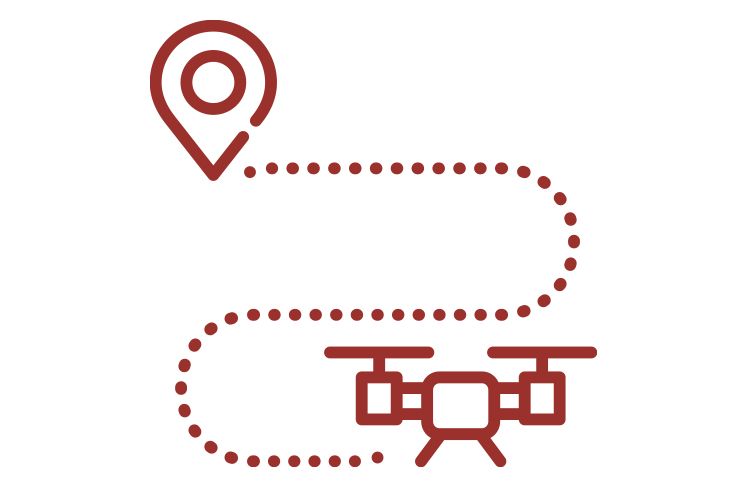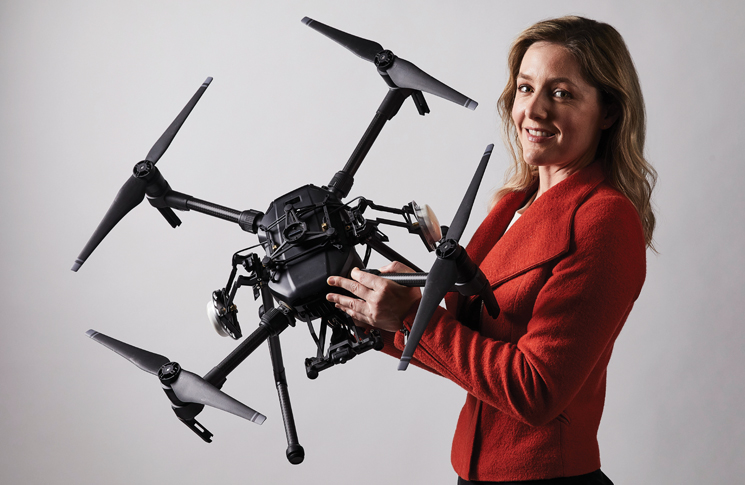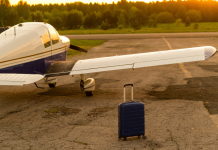Fiona Church has been a bush pilot, Qantas pilot and now a drone operator. Success in these diverse fields has 3 common ingredients, she says – checklists, planning and crew resource management.
What strikes you about Fiona Church is the way she continues to evolve, learning new skills along the way and trailblazing new technology.
For instance, she is a key driver of one of Australia’s first commercial drone services that is now writing software to turn images into 3D models. That’s very handy when the client wants inspections done on a tall building but cringes at the prospect of reviewing thousands of photos.
With your career crossovers, are there themes in a business or operational sense you’ve taken with you?
We found there was a lot of crossover between manned aviation and unmanned aviation. We started out in 2013 when we launched our first venture, Hoverscape, a drone service provider. That was during the very early days of commercial drone use in Australia, so we were one of the few companies using drones or RPAs to do commercial operations.
It was really beneficial having a manned aviation background because a lot of the RPA regulations were naturally taken from the manned regulations. So having that understanding, such as knowing about airspace, was very beneficial, not only to get our individual licence but also to get our remotely piloted aircraft operator’s certificate (ReOC).
Was there a lot of assumed knowledge in the regulations and directions?
Yes, there was. It was quite hard at the time for anyone who wasn’t already a pilot, because there was a lot of assumed knowledge. However, because we already had our commercial pilot licences, we ticked a lot of boxes that were required to get that ReOC. But to be approved as our chief pilot and be issued our ReOC, I had to go down to Canberra to do a flight test with CASA using one of the drones, which were a lot larger and more rudimentary than the drones we have these days – now they are a lot more advanced in terms of software and hardware and more user friendly. But it was a big advantage, coming from manned aviation, to have the knowledge base about airspace and be familiar with identifying and mitigating risks in the job planning stage which was part of the chief pilot’s role.
At the time, drone manufacturers didn’t provide checklists, so it was up to us to come up with one to cover all the pre-flight checks for the drone and camera systems which weren’t integrated, like they are now. We had to do system and propellor checks, compass calibrations, manually check the individual battery voltage and even oil the motors before we took off. So bringing over those foundations from manned aviation – to be thorough and follow a checklist – really helped us from a commercial point of view and with professionalising the way we were operating.
Is there an expectation that drones can go anywhere and do anything?
Yes, people did think drones can be flown anywhere but, as we know now, there are limitations about what the regulations permit you to do, because of safety. You often get clients who don’t understand what those limits are so, for example, they thought you could fly a drone over to the other side of the suburb from where you were standing. They don’t realise there is a line-of-sight limitation [that you had to keep the drone in sight]. And you often get people asking you to do things such as fly over very populated areas. You really have to know how to push back or explain to clients that we can only do things within certain parameters.
People did think drones could be flown anywhere.
Another crossover is some of the safety principles in aviation you adopted as business principles. One you mentioned is you need to admit you don’t know everything and that sounds like another expression for crew resource management. Is that how it worked out for you?
Yes, especially when we used to have one person flying the drone and another operating the camera. It’s a bit easier these days because the technology has advanced so much – it’s easier for one person to do both in some scenarios, but there are still situations where you have 2 or more people as part of the crew. It’s very important you do a proper briefing about how you’re going to achieve the outcome so everyone knows what they’re doing. It’s just like manned aviation where you have contingency plans, so if something doesn’t go to plan, you’ve already thought about how you’re going to act.
If I lose sight of the drone for some reason, what are my options to bring it back safely? If I lose transmission signal? What am I going to do if something like a helicopter comes out of nowhere and I hadn’t anticipated it, what are my actions going to be? Or if I have a motor failure on the drone, where could I manoeuvre the drone into a safe space?
There are lots of things that you need to plan out, so you’ve got them in your back pocket and you’re not having to then think and react at the same time. And it’s also important that your buddy, the person you are operating with, knows what you are doing.

Let’s go back to your earlier days. You had an engine failure on a Piper Chieftain near Darwin. Can you tell us what you learnt from that?
I left on a charter flight to pick up passengers and I’d got up into the cruise when I began hearing some abnormal noises coming from one of the engines.
My first reaction was to start diagnosing what the problem might be, such as checking the configuration of the controls. There wasn’t anything out of place but it wasn’t too long before that engine failed completely and feathered itself. I just looked over my left shoulder and saw it – the situation was very clear cut, which, in some ways, was a good thing.
What I learnt was to trust in the recalls and checklists to get yourself into a safe place. It was good to actually have to put them into practice in real life and trust that those actions work. But also, while it’s very good to have checklists and recalls, don’t stop thinking for yourself.
My action was to turn around and make my way back to Darwin, but I was constantly trying to plan for the next situation that might occur, for instance, what was I going to do if the other engine failed? I was flying over very hostile, crocodile-infested country and I thought, ‘What buffers can I put in place to make sure I don’t get into a worse situation?’
For example, planning the descent so you can get into a stable approach early means it’s less likely you’ll have to go around on one engine. And not forgetting other normal procedures that might still be important – in that particular aircraft, we had a set method of reducing the manifold pressure by one inch per thousand feet, so we protected that turbocharged engine against cooling shock.
So, after I completed the abnormal actions, I was very conscious of, ‘Don’t stop thinking about just doing your normal procedures – what can you do to make sure that the rest of the flight has some sort of buffer so that I can more likely be successful in coming into land without anything else affecting the flight?’
Checklists are very good because in those moments of pressure, you know you are going to cover all the big-ticket items.
It sounds like an interesting reflection on checklists. You sometimes hear people say that the checklist is a substitute for initiative and creative reactions, but the alternative is that taking checklist action actually frees you up to do those things. Which did you find?
Well, I think it’s a combination of both – I think checklists are very good because in those moments of pressure, you know you are going to cover all the big-ticket items. And you need a checklist to make sure that you’ve done all the basics. But it doesn’t give you much more than that. Okay, you know the basics are done, but now, for the rest of the flight, you need to make sure that you don’t get tunnel vision.
You are the pilot in command, you need to keep thinking, ‘Okay, now what? Okay, now I’ve done those initial options – how am I going to make sure that the rest of the flight is safe?’
While it’s very good to have checklists and recalls, don’t stop thinking for yourself.
And you’re able to do so because you’ve checked off all the killer items.
Yes, that’s right.
It sounds like your mind really went into overdrive and you were in a zone that very few pilots experience, which is the zone beyond the emergency checklist.
It was lucky for me because it happened in the cruise, so I was in a position where you’ve got a bit more thinking time and the chance to really plan.
Often, in general aviation, you might have practised initial actions to failures for an aircraft type, but you most likely have never carried them all the way through to a conclusion, such as landing and taxiing in on one engine. At Qantas, we do because we have the luxury of having simulators to practise in, which is a big advantage for practising all those steps beyond the emergency checklist.
The key thing is, definitely follow the recalls and checklists, they’re a very good tool, but then you need to bring yourself back to, ‘Okay, I’ve got to think for myself about how I’m going to conduct the rest of this flight’.
There’s not a checklist that’s going to give you all the answers. You just think about how you can plan as much as possible to mitigate against any new threats that might arise in that particular situation so you can avoid becoming overloaded. This is especially important when you are flying as a single pilot, in aircraft that don’t have a lot of automation to help you manage your workload.
Is there any situation in drone operations that has been comparable to the stress that you must have felt on that occasion?
When I did the CASA flight test, it was a requirement to fly in manual mode. There was no GPS and it was very, very difficult to fly in the manual mode. And I remember that was very stressful because manual mode took away all flight stabilisation and auto throttle which meant every little movement on the controls was a massive movement on the drone, and your reactions had to be lightning fast to keep it under control.
If that had actually occurred in real life and I had to revert to manual mode flying for that drone at the time – a 15-kilo drone, about a meter wide with 8 rotors, a big piece of technology – that would’ve been very challenging.
But they don’t do that anymore because, for a lot of drones, there’s not even an option to go into manual mode, you can’t even select that.
It must be exciting to be in an area of aviation where progress is so rapid?
Yes and that was part of the initial appeal, because we saw drones in their very early days and believed they would play a bit role in the future of aviation.
Coming from manned aviation, we thought this is not only a great opportunity but a natural fit for us – we will have a head start as we can transfer many of our skills and knowledge across.
There’s so much potential to use drones for a large variety of different tasks. We just have to look at how drones have since been utilised across many different industries to see how versatile they are – search and rescue, environmental monitoring and there are even drones that can string power lines now.
Being pilots and naturally technically and safety minded, we decided to focus on building and infrastructure inspections. Using a drone meant people could stay safely on the ground and avoid dangerous situations – before this engineers would have to dangling on ropes on the sides of buildings or bridges to do an inspection or use cherry pickers.
For us, our next problem to solve was how to make sense of all the drone data we were collecting, which is why we developed the software to bring it all together and enable our clients to do a digital inspection from their desktop. So, we felt like we would be on the forefront of this new industry and it was just unlimited potential what they could be used for.
Are there any practices or attitudes or knowledge areas where drone operation has something to teach manned aviation?
Over the past two decades the unmanned sector has evolved rapidly and has been able to take advantage of the latest technological innovations. RPA hardware and software components are now exponentially more sophisticated and robust, with multiple system redundancies, sensors and smart automation such as collision-avoidance technology. Not only this, the industry has matured and has a track record, which gives us confidence that we can continue to leverage the benefits of this agile technology across different industries, and work towards safe integration into Australia’s air traffic management system with piloted aircraft.
| CASA has developed a roadmap outlining our approach to aviation safety regulations for remotely piloted aircraft systems (RPAS), commonly referred to as drones, and advanced air mobility (AAM) over the next 10-plus years. Read about the RPAS and AAM Strategic Regulatory Roadmap on our website. |





